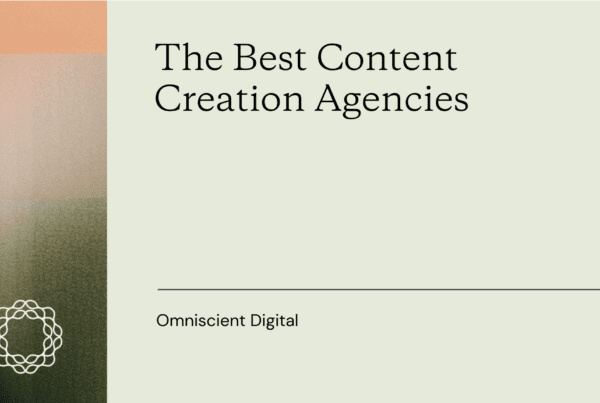
You’ve published a bunch of blog posts and maybe one or two have started ranking on page one of Google, but the others … they’re struggling.
Why?
You’re executing your content marketing strategy and created valuable SEO-driven content. That content is optimized for the target keyword, it’s comprehensive (over 2,000 words!), and you’ve even built backlinks.
Now it feels like you wasted your time because it’s not bringing in any traffic and no traffic means … no leads.
Content optimization is the answer here. It’s time to audit your content for refresh opportunities.
A content refresh could mean a few different content optimization strategies:
- Improving how you optimize for your target keyword by, get this, optimizing for other keywords
- Targeting a different keyword
- Make it more comprehensive
- Aligning the content with search intent and the search engines (this is usually the biggest challenge)
Let’s unpack these four ways to refresh your content to optimize for what people are searching for and search engine algorithms.
4 Content Optimization Strategies to Boost Performance
1. Optimize for your target keyword.
The most straightforward method in content optimization is to use the target keyword in the content. This is table stakes for content marketers.
The less straightforward optimization strategy is to optimize your content for additional related keywords.
Why?
We believe the Google PageRank algorithm identifies semantic keywords and correlates that with factors like SERP click-through rate, time-on-page, bounce rate, and more with rankings.
For example, if you’re writing a post about translation software, you’d want to look at the top ranking pages for translation software, you’ll find that the top pages all include similar phrases and keywords like: “cat tools,” “quality assurance,” “user management,” and so on.
There are keywords related to translation software that you should also include in your post.
Search engine optimization (SEO) tools like Ahrefs, Clearscope, Frase, and Marketmuse will help you uncover additional keywords and phrases to add to your content to get it up to page 1. They reverse engineer the search engines to help you create optimized content for that specific keyword.
Using Ahrefs, Site Explorer tool, you can look at the keywords a page ranks for.
For example, putting in the URL for the blog post we referenced above:

Shows the following results:

This shows all the related keywords that this page ranks for.
2. Target a different keyword.
The keyword you were initially targeting might be way too competitive to rank for. For example, the phrase “crm software” is competitive because there are a lot of websites creating content to target that keyword and the websites publishing that content have very high domain ratings (DR) or domain authority (DA).
Even with well optimized content, it will be very difficult, maybe impossible, for your website to rank for that keyword if your DR isn’t as high as those competitors.
But in targeting that keyword, you might end up ranking for other relevant keywords in the search engines. These keywords might be less competitive, have lower search volume, and/or higher purchase intent (which we’ll get to later) — or, ideally, all three!
For example, this post about meeting scheduling apps might have targeted the keyword “scheduling app” before because of it’s high search volume. But it had trouble ranking for it.

Then, it shifted to target “meeting scheduling apps” instead, which got them to rank for lower search volume keywords (but many of them). If you can rank for a lot of non-competitive keywords with low search volume, even though they individually have low search volume, in aggregate, that search volume adds up.

In this scenario, to remain SEO-driven, stay open to changing the goal of your article to target other relevant keywords that you’re more likely to rank on page 1 for.
3. Make your content more comprehensive.
In an ideal world, comprehensiveness isn’t the issue. Many content marketers default to creating very comprehensive content without doing their due diligence on what type of content actually ranks.
For example, I recently did a search for pour-over coffee. The search results show a mix of videos, recipes, pour-over coffee equipment, and blog posts.
Some of those blog posts define “what is pour-over coffee” and explain the importance of grind and brew time. Some have minimal written content and a lot of photos. And some just give me the step-by-step brewing instructions (thank you).
This shows that not all content has to be 5,000 words to rank on page 1.
Repeat after me: Long-form SEO content does not guarantee page 1 rankings. Optimizing content doesn’t have a silver bullet strategy. How you rank is more dependent on how well you match the search intent (see next section). This is core to search engine optimization in general.
However, if your content is indeed not as comprehensive as the content that already ranks on page 1, it would be a good idea to beef up your article.
4. Align your content with searcher intent
As search engine optimization has changed, search intent has become a more important ranking factor to consider when optimizing your content for search engines.
Understanding search intent is an exercise in empathy, putting yourself in the searcher’s shoes, and asking what they’d be looking for if they’re searching a particular phrase.
The content optimization exercise now involves not just adding keywords to content but looking at the search results to understand search intent.
The content that ranks on page 1 typically meets searcher intent — that’s why it ranks so highly.
Keep in mind that search intent changes over time as the audience for that topic changes or the audience’s familiarity with the topic changes.
Here’s an example of how to review search engine results to understand search intent.
The search results when searching for “kombucha” in 2013 …

… are different from the search results in 2021.

This might be a matter of kombucha becoming more popular over time that more people want to know kombucha recipes and the benefits of drinking than wanting to know what it is.
Search intent changes over time and search engine algorithms adapt to align with that intent.
There are two options to update your blog post to match search intent.
Update the content
After reviewing the search results, you might realize your blog post doesn’t address what people are looking for, but you still want to target that keyword.
In this case, update the content to match the intent.
For example, let’s pretend you’re a marketer writing about the podcast equipment, you’ll find that the top-ranking blog post about podcasting equipment talks about a lot of different types of podcasting equipment.
This tells us that readers may be trying to understand the whole podcast setup.
Meanwhile, your blog post only focuses on podcasting microphones and headphones.
You should update that blog post to include content to be more comprehensive. Smaller optimization strategies could also include beefing up meta descriptions and title tags, adding image alt tags, or formatting your blog post so it is likely to secure a featured snippet placement.
Split the content
Looking at the example above, it turns out a search for podcast microphones gives an entirely different set of search results.
This tells us searchers have a different intent and are looking for something more specific.
If we were to think in terms of content splitting here, we could split the original blog post into separate blog posts “best podcast microphone”, “best podcast headphone”, etc. to be more precise with matching search intent.
At the end of the day, this is a judgment call you’d have to make depending on your content strategy.
If we were providing content marketing strategy tips here, we’d recommend updating the general podcast equipment blog post to be about the best equipment in each category. Then create individual blog posts about the contending best microphones, headphones, etc. and link to those pages from the general equipment blog post.
This creates a web of related content for the reader to dive deeper in a specific topic.
How much of your content needs refreshing?
Audit your website for content optimization opportunities and make sure your content is performing the best it can.
Every piece of content has a job to match the specific searcher intent.
Content marketing is not just about choosing a target keyword and creating an article about that keyword.
Content marketing must now shift to an even deeper understanding of your target audience and what they’re looking for.



